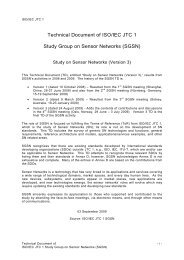Self-Timed SRAM for Energy Harvesting Systems - Electronics ...
Self-Timed SRAM for Energy Harvesting Systems - Electronics ...
Self-Timed SRAM for Energy Harvesting Systems - Electronics ...
You also want an ePaper? Increase the reach of your titles
YUMPU automatically turns print PDFs into web optimized ePapers that Google loves.
Figure 8 shows the access time of the <strong>SRAM</strong>. The access time is the latency from<br />
the reading/writing request to the done signal. For example, under 1V, the worst access<br />
time <strong>for</strong> writing and reading are 5.4ns and 3.0ns. And under 190mV, they are<br />
1.6µs and 4.0µs respectively.<br />
6 Conclusions and future work<br />
In this paper, we focus on <strong>SRAM</strong> memory design <strong>for</strong> energy harvesting systems.<br />
Normally, this kind of system works under a variable power supply with high power<br />
efficiency and not just low power. Under such non-deterministic power supply assumption,<br />
existing asynchronous <strong>SRAM</strong> working based on bundled delay has huge<br />
penalties and is impractical because a need <strong>for</strong> voltage references.<br />
The latency difference between <strong>SRAM</strong> memory and its controller under different<br />
Vdds is investigated. With reducing Vdd, the latency mismatch becomes bigger and<br />
bigger if traditional inverter chain delays are used. Under 190mV, the mismatch is<br />
more than twice bigger than under the normal 1V Vdd in 90nm technology.<br />
An SI <strong>SRAM</strong> is proposed and designed. The <strong>SRAM</strong> has a simple interface, which<br />
is similar to the normal <strong>SRAM</strong> including data, address, reading request, reading acknowledgement,<br />
writing request, and writing acknowledgement. The internal signals<br />
<strong>for</strong> memory control are fully triggered by the corresponding events of the memory<br />
systems. This works by monitoring the bit lines of memory.<br />
A new method is proposed to implement SI writing operation based on ideas from<br />
[14]. This solves the previously considered impractical or impossible problem of<br />
completion detection <strong>for</strong> writing operations.<br />
A 1Kb (64X16) SI <strong>SRAM</strong> is implemented using Cadence toolkits. The simulation<br />
results show the <strong>SRAM</strong> working as expected from 190mV to 1V. Meanwhile, the<br />
energy consumption and the worst case per<strong>for</strong>mance are measured. The measurements<br />
show the <strong>SRAM</strong> cell has acceptable characteristics.<br />
However, as the completion detection logic in SI <strong>SRAM</strong> is expensive in terms of<br />
area, per<strong>for</strong>mance, and power. A compromised <strong>SRAM</strong> is designed as well based on<br />
the modified SI <strong>SRAM</strong>.<br />
The new <strong>SRAM</strong> is based on the bundled delay principle. However unlike existing<br />
asynchronous <strong>SRAM</strong> solutions, a column (the worst column, if it can be identified) of<br />
SI <strong>SRAM</strong> cells doubles as delay elements. This column should be slower anyway than<br />
the other columns because completion detection elements take extra time. The other<br />
columns of the memory cells are bundled with this column.<br />
However, so far, we have only investigated basic asynchronous <strong>SRAM</strong> design.<br />
Other issues, such as static noise margin, readability, stability, etc. need further study.<br />
These are the targets of our future research. We will also investigate multi-port asynchronous<br />
<strong>SRAM</strong> in the context of variable and nondeterministic Vdd.<br />
Acknowledgement<br />
This work is supported by the EPSRC project Holistic (EP/G066728/1) at Newcastle<br />
University. During the work, we get very helpful discussions from our colleagues, Dr<br />
Alex Bystrov and other members of the MSD research group. The authors would like<br />
to express our thanks to them.
















